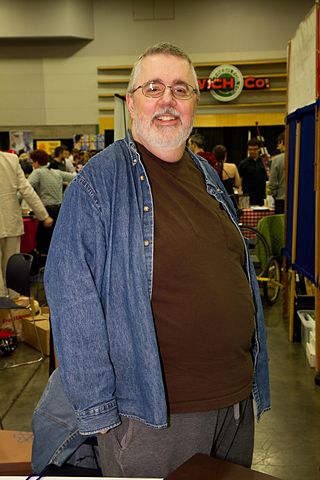Related Research Articles

William Erwin Eisner was an American cartoonist, writer, and entrepreneur. He was one of the earliest cartoonists to work in the American comic book industry, and his series The Spirit (1940–1952) was noted for its experiments in content and form. In 1978, he popularized the term "graphic novel" with the publication of his book A Contract with God. He was an early contributor to formal comics studies with his book Comics and Sequential Art (1985). The Eisner Award was named in his honor and is given to recognize achievements each year in the comics medium; he was one of the three inaugural inductees to the Will Eisner Comic Book Hall of Fame.

From Hell is a graphic novel by writer Alan Moore and artist Eddie Campbell, originally published in serial form from 1989 to 1998. The full collection was published in 1999 by Top Shelf Productions.
A graphic novel is a long-form work of sequential art. The term graphic novel is often applied broadly, including fiction, non-fiction, and anthologized work, though this practice is highly contested by comics scholars and industry professionals. It is, at least in the United States, typically distinct from the term comic book, which is generally used for comics periodicals and trade paperbacks.

Simon Bisley is a British comic book artist best known for his 1990s work on ABC Warriors, Lobo and Sláine.

Kurt Busiek is an American comic book writer. His work includes the Marvels limited series, his own series titled Astro City, a four-year run on The Avengers, Thunderbolts and Superman.

Brian Michael Bendis is an American comic book writer and artist.

Nelson Alexander Ross is an American comic book writer and artist known primarily for his painted interiors, covers, and design work. He first became known with the 1994 miniseries Marvels, on which he collaborated with writer Kurt Busiek for Marvel Comics. He has since done a variety of projects for both Marvel and DC Comics, such as the 1996 miniseries Kingdom Come, which he also cowrote. Since then he has done covers and character designs for Busiek's series Astro City, and various projects for Dynamite Entertainment. His feature film work includes concept and narrative art for Spider-Man (2002) and Spider-Man 2 (2004), and DVD packaging art for the M. Night Shyamalan film Unbreakable (2000). He has done covers for TV Guide, promotional artwork for the Academy Awards, posters and packaging design for video games, and his renditions of superheroes have been merchandised as action figures.

Norman Rufus Colin Cohn FBA was a British academic, historian and writer who spent 14 years as a professorial fellow and as Astor-Wolfson Professor at the University of Sussex.

Brian K. Vaughan is an American comic book and television writer, best known for the comic book series Y: The Last Man, Ex Machina, Runaways, Pride of Baghdad, Saga, and Paper Girls.
Matvei Vasilyevich Golovinski was a Russian-French writer, journalist and political activist. Critics studying The Protocols of the Elders of Zion have argued that he was the author of the work. This claim is reinforced by the writings of modern Russian historian Mikhail Lepekhine, who in 1999 studied previously closed French archives stored in Moscow containing information supporting Golovinski's authorship. Back in the mid-1930s, Russian testimony in the Berne Trial had linked the head of Russian security service in Paris, Pyotr Rachkovsky, to the creation of The Protocols.

The Dialogue in Hell Between Machiavelli and Montesquieu is a political satire written by French attorney Maurice Joly in protest against the regime of Napoleon III, who ruled France from 1848 to 1870. It was translated into English in 2002. Small portions were translated in 1967 as an appendix to Norman Cohn's Warrant for Genocide, which identifies it as the main source of the later Protocols of the Elders of Zion, though The Dialogue itself makes no mention of Jews.

Hermann Ottomar Friedrich Goedsche, also known by his pseudonym Sir John Retcliffe, was a German government employee and author who is remembered mainly for his antisemitism.

Goran Sudžuka is a Croatian comic book artist, known for his work on books such as Y: The Last Man, Hellblazer: Lady Constantine and Ghosted.

Cameron Stewart is a Canadian comic book creator. He first came to prominence when he collaborated as an illustrator with writer Grant Morrison, and he went on to illustrate Catwoman and co-write Batgirl. He won Eisner and Shuster Awards for his self-published mystery web comic Sin Titulo, and received an Eisner nomination for The Other Side.

Herman Bernstein was an American journalist, poet, novelist, playwright, translator, Jewish activist, and diplomat. He was the United States Ambassador to Albania and was the founder of Der Tog, the Jewish daily newspaper.

The Protocols of the Elders of Zion, or The Protocols of the Meetings of the Learned Elders of Zion, is a fabricated text purporting to detail a Jewish plot for global domination. Largely plagiarized from several earlier sources, it was first published in Imperial Russia in 1903, translated into multiple languages, and disseminated internationally in the early part of the 20th century. It played a key part in popularizing belief in an international Jewish conspiracy.

Ulrich Fleischhauer was a leading publisher of antisemitic books and news articles reporting on a perceived Judeo-Masonic conspiracy theory and "nefarious plots" by clandestine Jewish interests to dominate the world.
The Protocols of the Elders of Zion is a fabricated antisemitic text purporting to describe a Jewish plan to achieve global domination. The text was fabricated in the Russian Empire, and was first published in 1903. While there is continued popularity of The Protocols in nations from South America to Asia, since the defeat of Nazi Germany, Fascist Italy, and Imperial Japan in World War II, governments or political leaders in most parts of the world have generally avoided claims that The Protocols represent factual evidence of a real Jewish conspiracy. The exception to this is the Middle East, where a large number of Arab and Muslim regimes and leaders have endorsed them as authentic. Past endorsements of The Protocols from Presidents Gamal Abdel Nasser and Anwar Sadat of Egypt, Iraqi President Arif, King Faisal of Saudi Arabia, and Colonel Muammar al-Gaddafi of Libya, among other political and intellectual leaders of the Arab world, are echoed by 21st century endorsements from the Grand Mufti of Jerusalem, Sheikh Ekrima Sa'id Sabri, and Hamas, to the education ministry of Saudi Arabia.

The Holy Blood and the Holy Grail is a book by Michael Baigent, Richard Leigh, and Henry Lincoln.
The international Jewish conspiracy or the world Jewish conspiracy has been described as "the most widespread and durable conspiracy theory of the twentieth century" and "one of the most widespread and long-running conspiracy theories". Although it typically claims that a malevolent, usually global Jewish circle, referred to as International Jewry, conspires for world domination, the conspiracy theory's content is extremely variable, which helps explain its wide distribution and long duration. It was popularized in the late nineteenth and early twentieth century especially by the antisemitic forgery The Protocols of the Elders of Zion. Among the beliefs that posit an international Jewish conspiracy are Jewish Bolshevism, Cultural Marxism, Judeo-Masonic conspiracy theory, White genocide conspiracy theory and Holocaust denial. The Nazi leadership's belief in an international Jewish conspiracy that it blamed for starting World War II and controlling the Allied powers was key to their decision to launch the Final Solution.
References
- 1 2 3 Heller 2005.
- 1 2 Lezard 2006.
Works cited
- Heller, Steve (Autumn 2005). "Eisner puts straight an anti-semitic slander". Eye Magazine . Retrieved September 9, 2015.
- Lezard, Nicholas (July 22, 2006). "The enduring power of lies". The Guardian . Retrieved September 9, 2015.